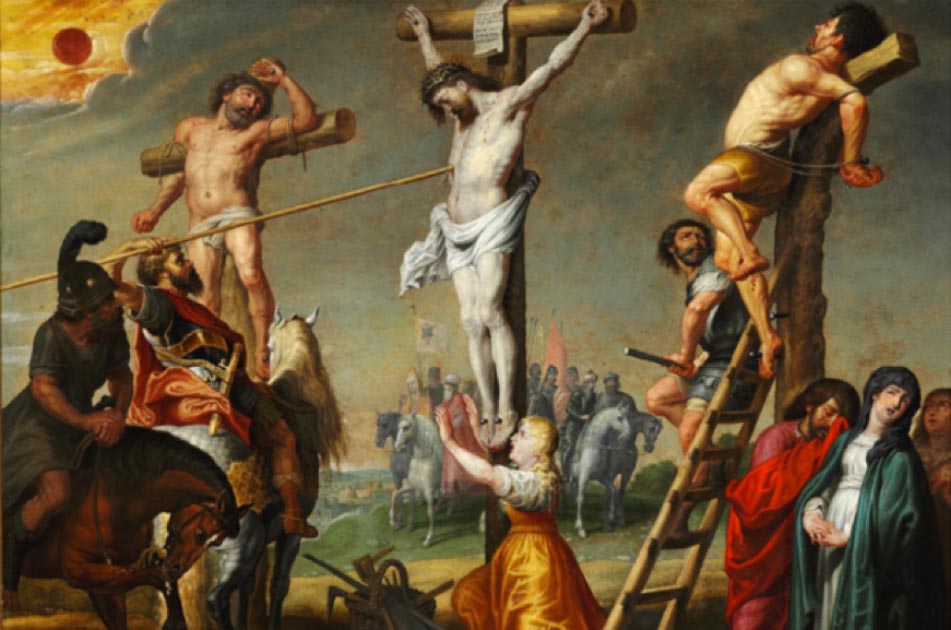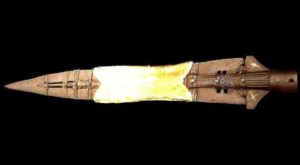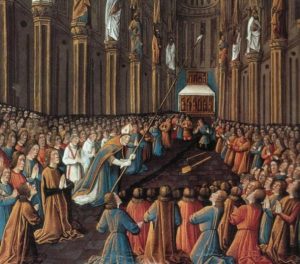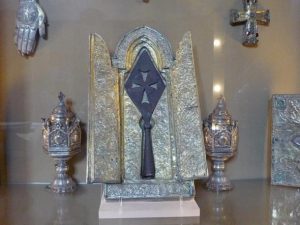Cracking the Veil: Revealing The Holy Lance’s Secrets

Christianity, as one of the world’s most prominent and widely practiced religions, brings along a whole string of myths, stories, historical occurrences, and relics. From saints and their remains, to alleged fragments of the Holy Cross, all the way to the fabled Holy Grail – the Christian worshipers have sought and revered these holy relics for centuries. But what happens when a relic appears…twice? Or three or four times? To whom will the worshippers flock? Today we are discovering just that , as we explore the story of the Holy Lance, often known as the Spear of Longinus. There are several alleged lances in the Christian world, each one revered as the very one that pierced the body of Christ. But whether that’s correct, remains to be seen. Thrust the spears!
Before we delve deeper into the authenticity of these lances, we should remind ourselves of the actual story that lies behind it all. What is likely one of the holiest Christian relics, the Spear of Longinus, is mentioned in the Bible, in the Gospel of John. When Jesus was nailed to the cross and crucified, as per Roman practice, the Romans were about to break his legs. This was usually done to hasten the demise but also too increase the suffering of the victim, as they would not be able to support their weight at all. This practice was known as crurifragium.
The Early History of the Holy Lance
On the day of Jesus’ crucifixion, there were three crosses erected, and three men crucified. Besides Jesus Christ there were the two thieves – Dismas and Gestas. Their legs were broken, but when the soldiers approached Christ, they noticed he was already dead. To simply confirm this fact, a centurion named Longinus thrust his spear into the side of Christ, and the story goes that, to their amazement, blood and water flowed from the wound.

Depiction of the crucifixion of Jesus (Travis / CC BY-NC 2.0)
The legend states that Longinus, wholly astonished at this miracle, repented for piercing the son of God, and later on converted to Christianity. He became a saint and is venerated in several Christian denominations. Since then, wherever a purported lance came up it was revered as a relic of utmost holiness.
Holy Lance of Vienna
The first ‘Holy Lance’ we will discuss is kept in Vienna. This magnificent looking spearhead is displayed in the Weltliche Schatzkammer, also known as the Imperial Treasury. This treasury is located at Hofburg Palace, the former seat of the Imperial Habsburg dynasty, and nowadays the seat of the Austrian president. The spearhead itself is an elaborate and powerful winged lance, typical for the period of the Carolingian dynasty, with a broad base, a curving and tapered mid-section, which broadens towards the point. At a first glance, the spearhead seems too elaborate and ceremonial to be a simple soldier’s spear that pierced the side of Christ.
The earliest mention of the spear dates to the period of Otto I, who lived from circa 912 to 973. From him it remained in the possession of the Holy Roman Emperors. The next mention dates to 1000 AD, when Bolesław I Chrobry, the first King of Poland, acquired a replica of the lance from Otto III. Less than a century later, the Holy Roman Emperor Henry IV decided to add a silver band across the middle section, on which was written “ Nail of Our Lord”. At a later date, this silver band was covered with a golden one by Charles IV, which remains to date. The golden sleeve bears the inscription: “ Lancea et Clavus Domini” (The Lance and the Nail of the Lord).

The Holy Lance held in Schatzkammer, Vienna, Austria (René Hanke / CC BY-SA 3.0)
The so-called Nail of Our Lord refers to the iron nail that has been wrought and hammered into the lance itself. The legend states that it was one of the nails that pinned Christ to the cross.
Around the beginning of the thirteenth century, the Vienna lance became increasingly connected with the Holy Lance, seemingly to be used as a symbol of power and influence over the believers. It wasn’t until 1424 that the lance changed locations. Holy Roman Emperor Sigismund of Luxembourg moved the lance to Nuremberg, ordering that it be kept there forever.
But how did it come to Vienna? Well, that happened in 1796, when the French Revolutionists approached Nuremberg. To preserve the relics, the officials hastily moved them to Vienna. The plan was to keep them there until the conflict was over. But the conflict did not cease, and the Holy Roman Empire disbanded in 1806. The lance, in the chaos that engulfed Europe, found its way into the hands of the Habsburg dynasty.

Depiction of the discovery of the Holy Lance (Jean Colombe / Public domain)
The developments in the later decades weren’t really kind to this relic, either. The Habsburgs dissolved in 1918, and several years after, Austria was annexed by Adolf Hitler at the head of Germany. With that, all the relics from Vienna, including the lance, were transferred to Nuremberg. They were on display for a short while, and afterwards hidden in the “Historical Art Bunker,” an underground storage unit that held only precious items. It was located beneath the Nuremberg Castle. Even after the war ended the victors couldn’t find the relics. Only after rigorous interrogations of the Nuremberg council were they recovered, and then hidden once more in a secret underground passageway. They have been in Vienna ever since.
Science Uncovers the Secrets
The lance was tested several times in the hope of improving its authenticity. In 2003, Dr. Robert Feather was granted permission to conduct detailed scientific tests under strict supervision. The tip was tested repeatedly in order to discover any traces of blood or DNA. None were found. Radiography work consisted of an x-ray diffraction and fluorescence tests, revealing the composition of the material that helped determine the age. The results were almost the same as previous tests – the spear was manufactured in the 7th or 8th century AD – long after the time of Jesus Christ.
Although it is still called the Holy Lance, bears all the inscription is venerated as a relic, this spearhead is not the true article. The search for the true spear continues.
Holy Lance of Armenia
The next alleged Holy Lance is kept in Armenia, in their religious capital of Echmiadzin. Armenia is one of the world’s oldest Christian countries, and the lance kept there has a long history. It has been kept in the medieval Geghard monastery since the Middle Ages. The name itself means The Monastery of the Holy Lance. Earliest mentions date to the 12th and the 13th centuries, relating the legend that the spearhead was brought to Armenia by the Apostle Thadaeus. In 1268, Prince Prosh encased the lance into a lavish display case, but it was replaced in the 1600s with a new case, which it is in today.

The Holy Lance held in Museum of Echmiadzin, Armenia (Emanuele Iannone / Public domain)
The belief of Armenian Christians that this truly is the Spear of Longinus is strong, even though the origins of the item are lost to time. But from the first glance, there is something not quite right with the Echmiadzin lance – its look. It takes one look to realize that this spear head is anything but an actual weapon. It is so unlike a lance that most likely it couldn’t pierce anything. Its look is purely ceremonial. Now, some claim that the actual lance was re-forged into the current form, but this is debatable. It is said that it was at this time that the iconic cross was stamped into the spear head giving it the current look.
Seemingly no tests were carried out on this spearhead, and its authenticity remains a thing of debate.
The Holy Lance in the Basilica of St Peter, Rome
The third important ‘Holy Lance’ is kept in Rome, in the Basilica of Saint Peter. It has one of the oldest mentions in the historical sources and had quite a story through the centuries.
It was first mentioned in 570 AD by Antoninus of Piacenza, who describes it as a holy relic in the Basilica at Mount Zion. The existence of such a relic in Jerusalem was attested on other occasions as well, by Gregory of Tours and Cassiodorus. Around 615, the lance suffered damage, when the Persian king Chosroes II captured Jerusalem. The very tip of the lance was broken off. The point was then separated from the rest, and sent to Constantinople and placed into Hagia Sophia, where it was considered holy, and encased in an icon. The icon gradually found its way into the hands of Louis IX of France, who displayed it in Paris’ Saint Chapelle. After the chaos of the French Revolution, the tip of the lance was lost. Only a drawing remained, and at one point it was used to determine the connection between the two pieces. Pope Benedict claimed that it was a 100% accurate fit – the tip belonged to the spear in Rome.
The rest of the lance remained in Jerusalem, but was eventually transferred to Constantinople, seemingly in the 8th century. It remained there and was attested by numerous pilgrims that came to see it from all corners of the Christian world. That is, until Constantinople fell to the Turks. In 1492, seeking to get on the good side of the Pope, the Sultan Bayezid II sent him the larger part of the Holy Lance. The Pope held the Sultan’s main rival imprisoned, and Bayezid wanted to make sure it remained so. Since then, this holy relic remained enshrined in Rome. But its authenticity was always in question. With many other relics claiming to be the very same thing, it is impossible to say for certain which is the real deal. And thus, the Catholic Church never officially claimed that it is the authentic Spear of Longinus. Today it rests beneath the dome, crowned with a larger than life statue of Saint Longinus, holding the spear that is so akin to the one found in Armenia.

The statue of Saint Longinus holding the Holy Lance in St. Peter’s Basilica, Rome (Public domain)
The Relic Market
Throughout the Middle Ages, the so called ‘Relic Industry’ was working at full speed. Catholicism wanted to strengthen the faith of its believers, and other denominations wanted the same thing. So holy relics began popping up with increased frequency. Several different Holy Sponges were revered, countless fragments of the Holy Cross, Crowns of Thorns, and so forth. At one time, at least thirty different Holy Nails existed in Europe. The church even went so far as to claim they possess Jesus’ Holy Prepuce (foreskin) and his umbilical cord. Bones and skulls of saints and apostles appeared in several places at once. Random skeletons were bejeweled and sold as remains of Holy Martyrs and Saints. These were known as Catacomb Saints and were widely sold to churches and noble families across Europe. The thing was, they weren’t saints.
None of these were determined to be authentic, unique, or historically accurate remnants of the Passion of Christ. This fact poses a lot of questions about advocating veneration of such relics and the truth of the holy cause.
A Spear to Command Destiny
Throughout the course of history, plenty of theories surrounded the Holy Lance, and some even went to extremes. In the Middle Ages certain Germanic dynasties claimed it was Gungnir – Odin’s mythological spear. This was done, again, to assert their rule and nobility.
Adolf Hitler’s rule brought about a resurgence of occult practice, and one of the myths was connected to the Holy Lance in Vienna. According to the occultists, it was called the Spear of Destiny. Whoever possessed it was destined to rule the world. And naturally, Hitler wanted it for himself. This myth further mentions the belief that whoever lost possession of the Spear of Destiny would die.
It is interesting to think that generations of believers venerated relics of whose authenticity nothing was known. It gives us a deeper understanding of faith and religious zeal, which is often unshakable. But even so, the stories of the holy relics and the Spear of Longinus are an interesting insight into the religious movements of the European Middle Ages.